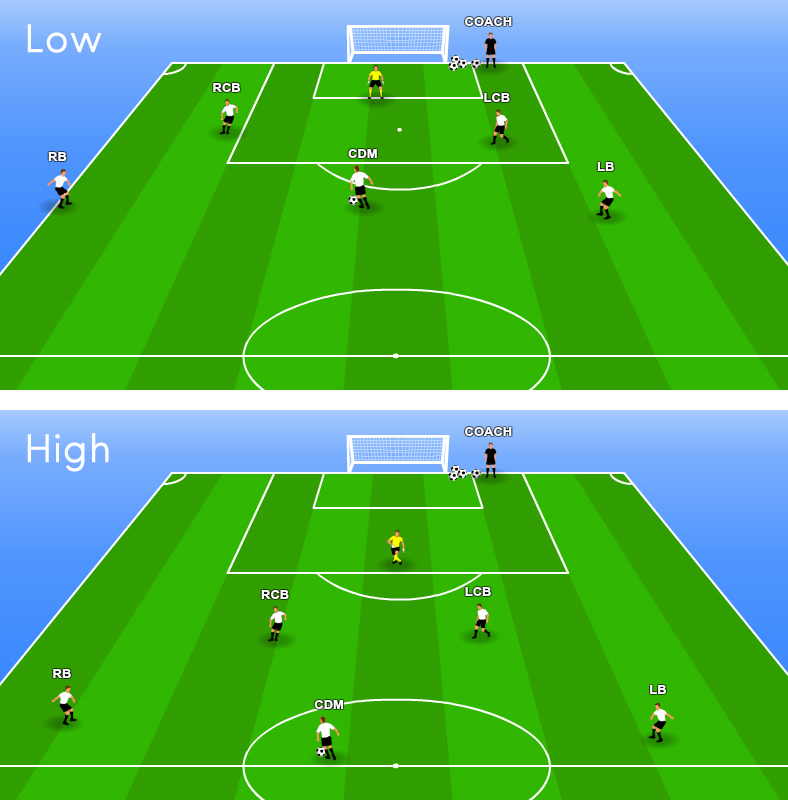Playing Out From the Back - Unopposed
- Author: Ian Knapp
- Age Group: U9 to U17+
- Time: 20 minutes
Introduction:
This is a very simple, unopposed practice, that helps your players understand their individual and team roles when playing out from the back. Positioning and movement as a unit are the key points here, whilst the quality of the passing and each player's receiving skills, first touch and body shape all need to be of a high standard if the team are to be effective. If your players are struggling with those aspects, return to the foundation skills required to play from the back.
Setup:
- Full pitch width
- Work with your goalkeeper, defenders and defensive midfielder (numbers will depend on whether you play 7v7, 11v11 etc.)
- Plenty of footballs with the goalkeeper
- Coach at side with more footballs
- Players set up on the pitch to give the goalkeeper options to play effectively from the back (more info on positioning to play from the back is here)
Basic Rules:

- Starting from the goalkeeper, the aim is simply for the players to keep possession of the ball and to work it up and down the pitch and from side to side.
- Players move as a unit both horizontally and vertically on the pitch, so if the left back has the ball, the whole team has shifted across to the left to give him / her options to play to and if the left back drives forward down the line, the whole team steps up (see below diagrams)
- Ball should be moved quickly.
- Once the players reach the half way line, or if the ball is miscontrolled and goes out, players must immediately reset to their starting positions and we play from the goalkeeper again.
- Encourage variety from the players - sometimes check and go back, sometimes drive forward, sometimes switch play directly, sometimes switch through the CDM or the centre backs.
5 Key Coaching Points:
- Players to receive the ball on their back foot (letting the ball run across their body to their "opposite" foot) and passing empathy to allow for this (ie don't pass a metre behind the player)
- Players move AS A UNIT (including the goalkeeper) both horizontally (across the pitch) and vertically (up and down the pitch). No player should be left stranded and out of position. When the ball is central, players are spread evenly, when it is on the left, the whole team has shifted left etc. See below for more info on this.
- As the ball shifts, movement off the ball must be as the ball is travelling - don't wait until the player has the ball to start moving to be an option.
- Gaps between players should never be too big - if we lose the ball we need to be in a position to cover. The size of the gaps depends on the age of the players and their ability to pass over those distances.
- Communication (tell the player on the ball what to do with it). GK particularly can see the whole pitch, so encourage plenty of chat from GK.
Moving as a Unit
Key to playing effectively from the back is moving as a unit. This means both vertically (up and down the pitch) and horizontally (across the pitch). The diagrams below show how the players might look when the midfielder has the ball in a deep position (low), near to his / her own goal and in a higher position (high - nearer the half way line).

In both diagrams, the central midfielder has the ball and is about to pass to one of the players on the right hand side of the pitch (left as we look at it), so note how the whole team are shifting across in anticipation of that pass. If the team don't move as a unit, we are in danger of being exposed if we lose the ball and we also have very big gaps for the players to pass over. If the centre mid were to turn and decide to pass to one of the left sided defenders, we would expect those players to back up toward the touchline and the right sided players (left as we look at it) to shift across as cover.
So encourage the players to move as a unit and to anticipate what is about to happen and start their movement before the pass is played based on what it looks like the player with the ball is about to do.
The above has all been illustrated for 11 a side football, but the same principals apply for 7v7 and 9v9. In a 7v7 mini soccer game, the above could represent your 2 defenders, midfielder and 2 wingers. All the same coaching points apply.
Coaching Points (FA's 4 Corners):
| Technical | Psychological |
|---|
- Receiving the ball onto the back foot.
- Passing to the correct foot of the receiving player.
- Weight of pass
- First touch (take the ball where you want for you to play your next pass)
- Move as a unit
- Movement off the ball
- Size of gaps between players
- Create options for the player on the ball (always a minimum of 2)
|
- Communication (tell the player on the ball what to do with it)
- Decision making - which player to pass to (decide BEFORE the ball has arrived with you)
- Concentration - move as a unit, keep the team "shape"
- Anticipate and move based on what you think your team mate with the ball is about to do.
|
| Physical | Social |
|---|
- Speed of play
- Body shape
- Fitness and speed to get up and down the pitch as a unit
|
- Working as a team
- Encouraging others
- Communication
- Have fun!
|